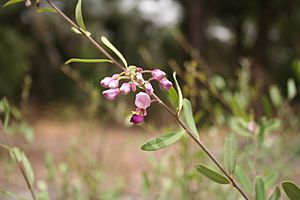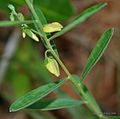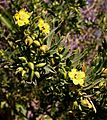Fabales facts for kids
Quick facts for kids Fabales |
|
|---|---|
 |
|
| Scientific classification | |
| Kingdom: | |
| Division: | |
| (unranked): | |
| Order: |
Fabales
|
| Families | |
|
|
The Fabales is a group of flowering plants. Scientists call these groups "orders." Think of it like a big family tree for plants! This order is part of an even larger group called rosids, which are a type of eudicot. Eudicots are a major group of flowering plants.
Scientists use different ways to classify plants. One common system today is called the Angiosperm Phylogeny Group II (APG II) classification. In this system, the Fabales order includes four main families:
- Fabaceae (also known as legumes)
- Quillajaceae
- Polygalaceae (the milkwort family)
- Surianaceae
Some older ways of classifying plants, like the Cronquist system, grouped these families differently. For example, the pea family was the only one in Fabales, while the others were in separate orders. But with new research, scientists have updated how they group plants, and now these four families are together in the Fabales order.
Contents
What are Plant Orders?
Plants are organized into different groups to help us understand them better. This is called classification. It's like sorting your toys into categories: cars, action figures, board games, and so on.
Scientists group plants based on their shared features and how they are related.
- A "species" is a specific type of plant, like a sunflower.
- Similar species are grouped into a "genus."
- Similar genera (plural of genus) are grouped into a "family."
- And similar families are grouped into an "order," like the Fabales.
This system helps us see how all living things are connected.
Families in the Fabales Order
The Fabales order is home to some very interesting plant families. Let's explore them!
The Pea Family (Fabaceae)
The Fabaceae is the largest family in the Fabales order. It's also one of the largest families of flowering plants in the world! This family includes many plants you might know, like:
- Peas
- Beans
- Lentils
- Peanuts
- Clover
- Alfalfa
Plants in the Fabaceae family are super important. Many of them are used as food for humans and animals. They also help the environment by adding nitrogen to the soil, which acts like a natural fertilizer. This process is called nitrogen fixation.
Quillajaceae
The Quillajaceae family is much smaller. It only has one genus called Quillaja. The most famous plant in this family is the soap bark tree (Quillaja saponaria).
This tree is native to South America. Its bark contains chemicals called saponins, which can create a foamy lather when mixed with water. People have used it for a long time as a natural soap. It's also used in some drinks and medicines.
Polygalaceae
The Polygalaceae family is often called the milkwort family. It's a diverse group with many different kinds of plants. They can be herbs, shrubs, or even small trees.
You can find plants from the Polygalaceae family all over the world. They often have unique flowers that look a bit like butterflies. Some species are used in traditional medicine.
Surianaceae
The Surianaceae family is another small group within the Fabales order. It includes shrubs and small trees. One well-known plant from this family is the Bay cedar (Suriana maritima).
The bay cedar is a shrub that grows in coastal areas, especially on sandy beaches. It's found in tropical and subtropical regions around the world. It has small, yellow flowers and is often used to help stabilize sand dunes.
Why are Fabales Important?
The plants in the Fabales order are incredibly important for many reasons:
- Food: The Fabaceae family provides a huge amount of food for people and animals worldwide. Think of all the protein from beans and lentils!
- Environment: Many Fabaceae plants improve soil health by fixing nitrogen. This reduces the need for chemical fertilizers.
- Medicine and Industry: Some plants, like the soap bark tree, have special chemicals used in medicine or other products.
- Biodiversity: This order shows the amazing variety of life on Earth, from tiny herbs to large trees.
Studying orders like Fabales helps scientists understand how plants have evolved and how they interact with their environment.
Images for kids
-
Tuberous pea (Lathyrus tuberosus) of the Fabaceae
-
Soap bark tree (Quillaja saponaria) of the Quillajaceae
See also
 In Spanish: Fabales para niños
In Spanish: Fabales para niños







